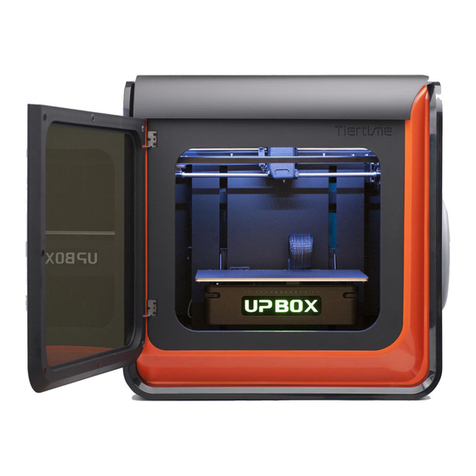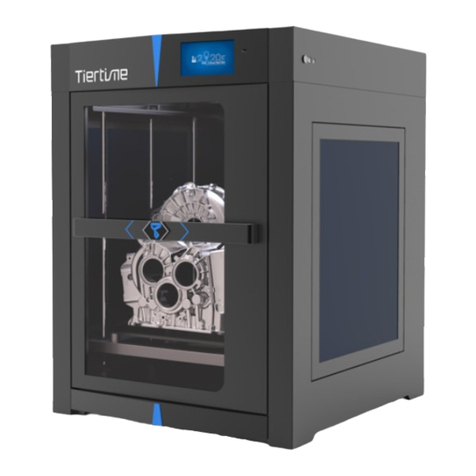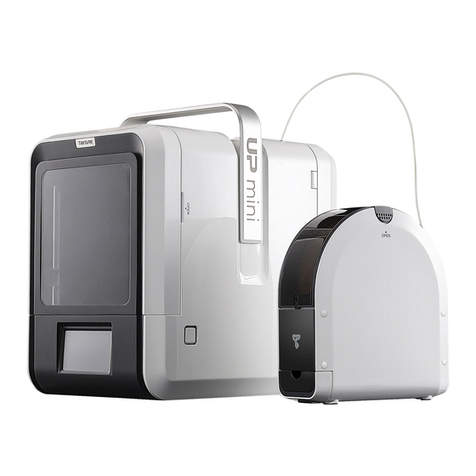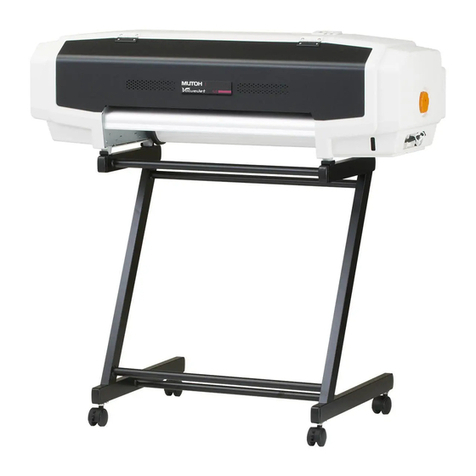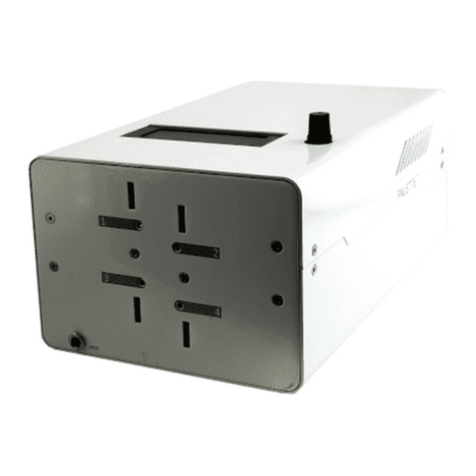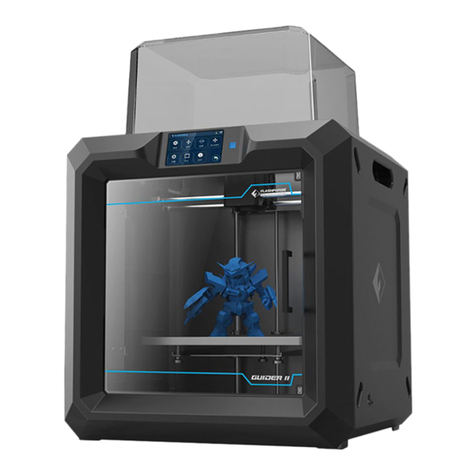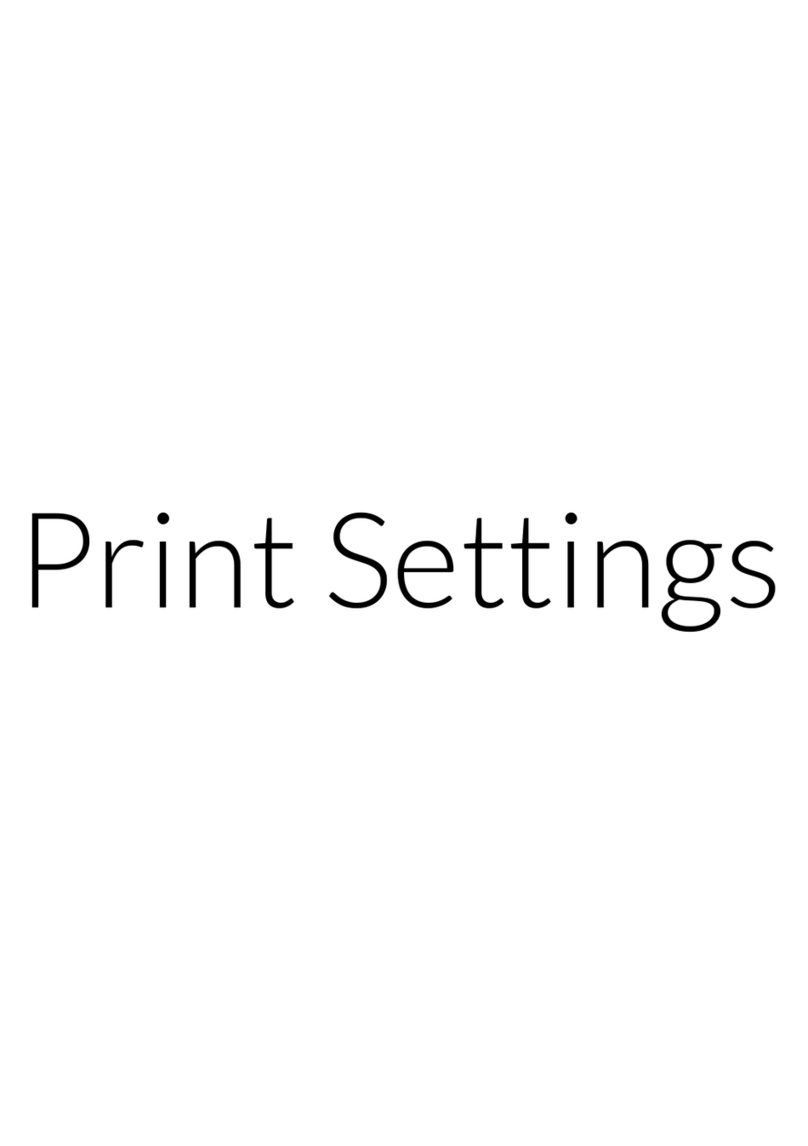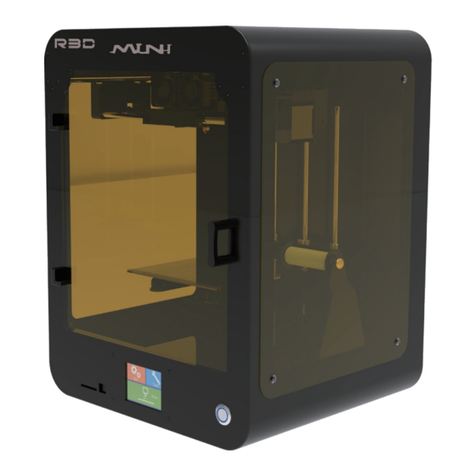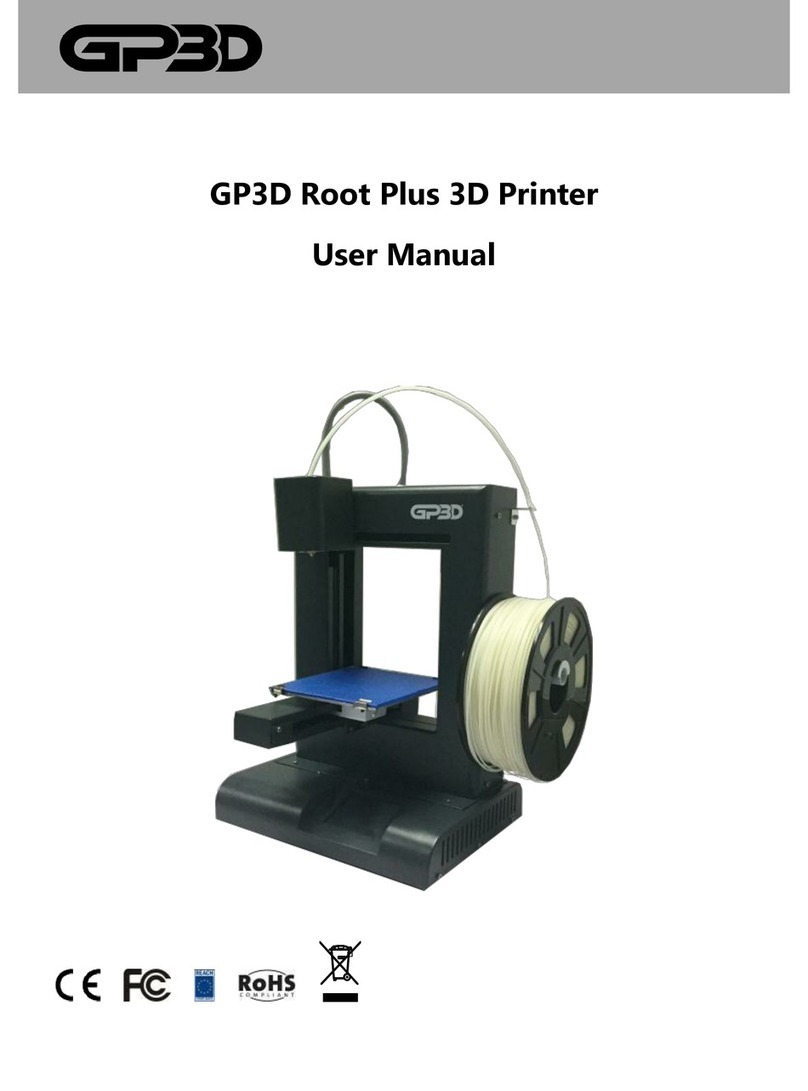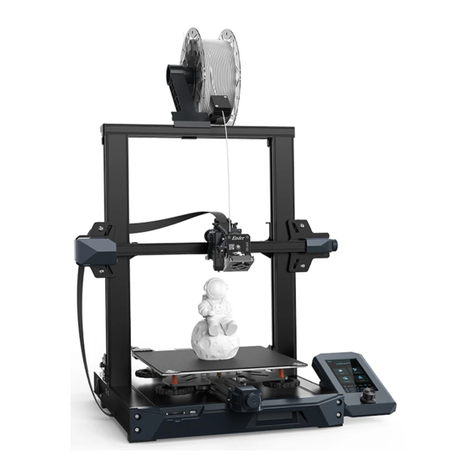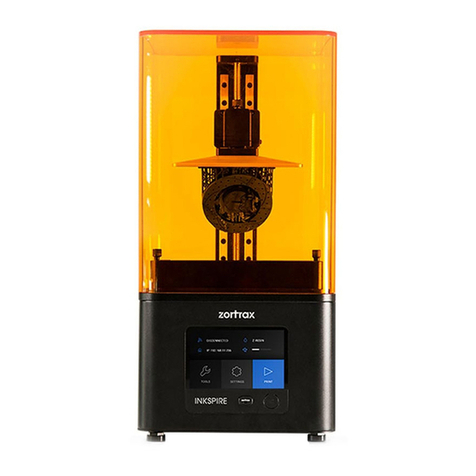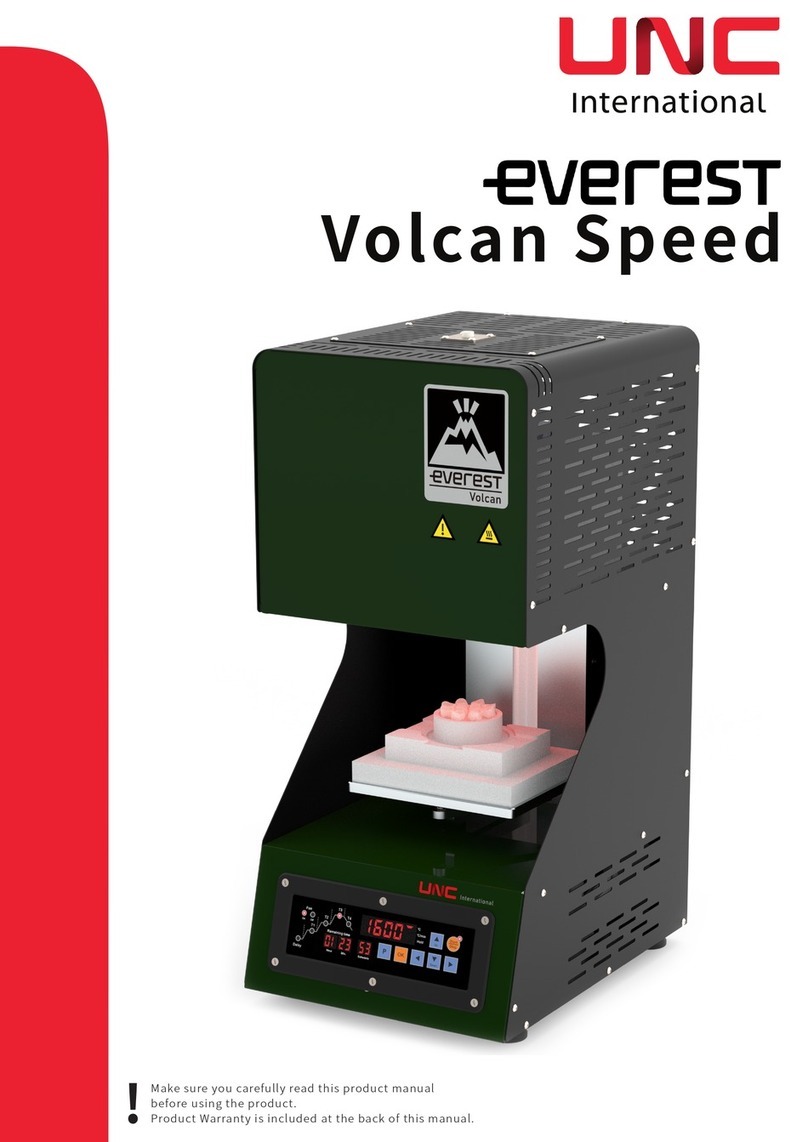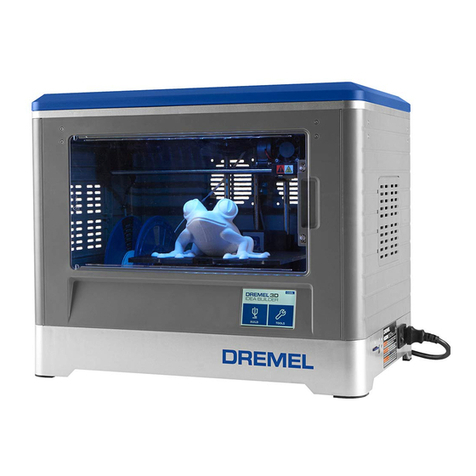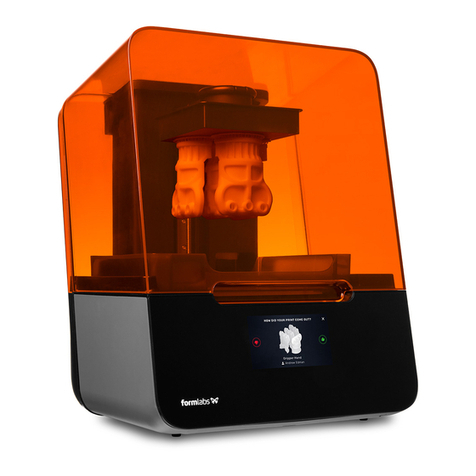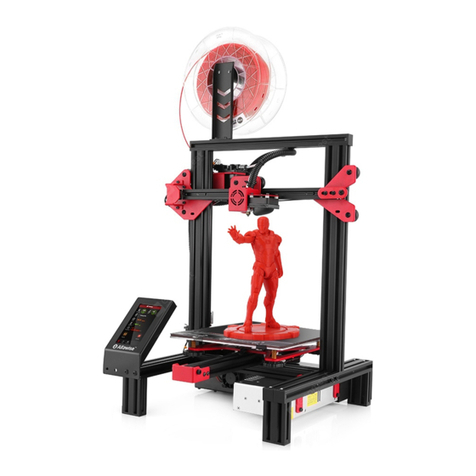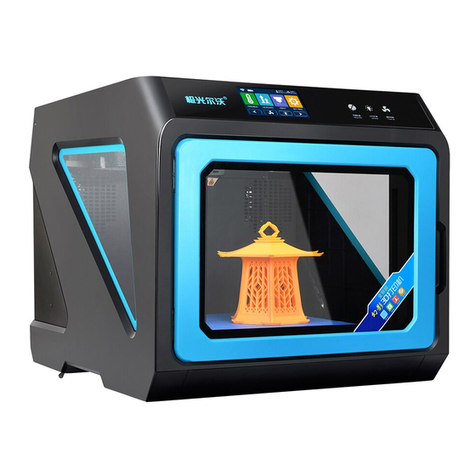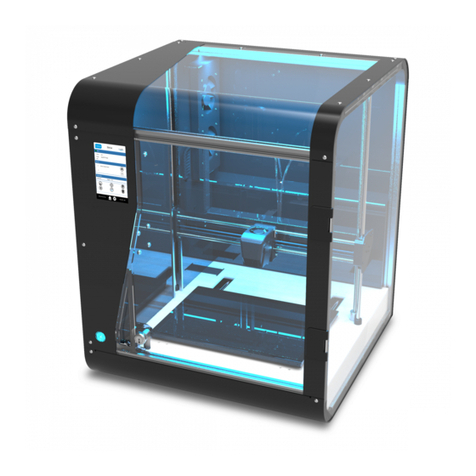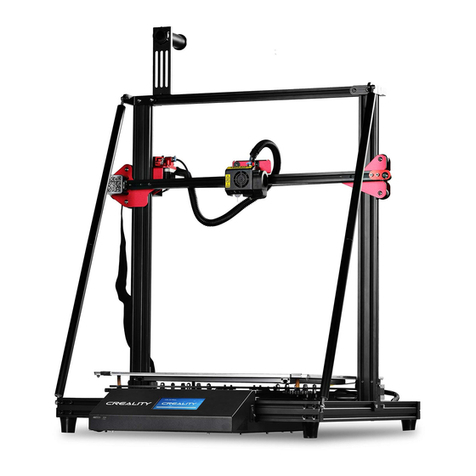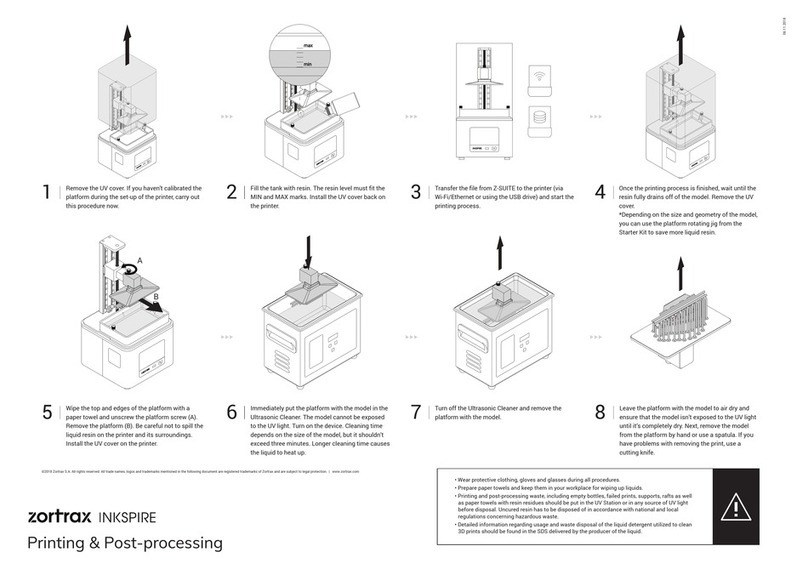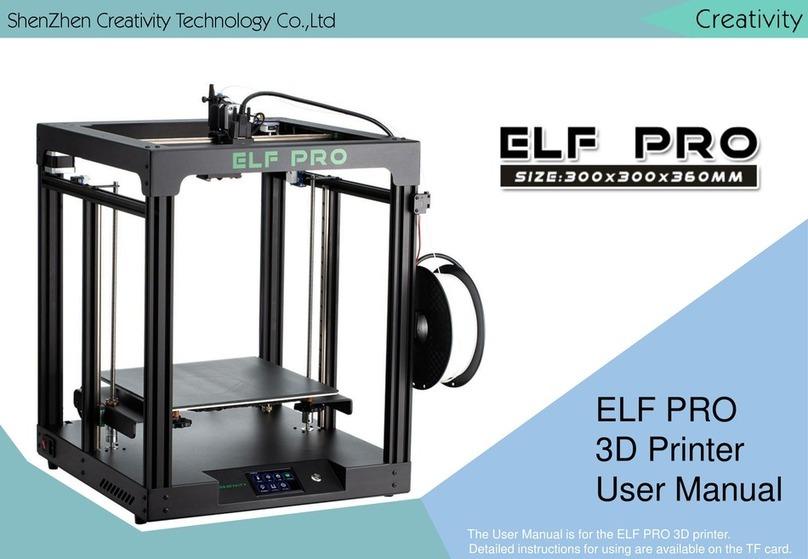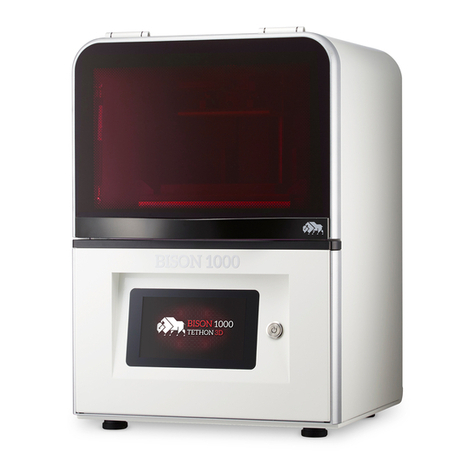TierTime UP mini User manual

version:4.6.23
UP mini
user manual

Table of Content
Precautions .......................................................................................................................... 01
Printer Body illustration .................................................................................................. 03
Accessories .......................................................................................................................... 05
Installing the Print Head ................................................................................................ 06
Install the Perf Board ....................................................................................................... 07
Install UP Software ........................................................................................................... 08
Initialization of Printer ..................................................................................................... 09
Platform Calibrate
1.Setting Nozzle Height ...................................................................................... 11
2.Setting Compensation Values......................................................................13
Prepare for Printing ..........................................................................................................14
Loading a Model ................................................................................................................. 15
Software Interface .............................................................................................................17
Moving Model ...................................................................................................................... 18
Rotate Model ....................................................................................................................... 19
Scale Model .......................................................................................................................... 19
Duplicate Model ..................................................................................................................
20
Printing Parameters .........................................................................................................
20
Annotation for Printing Parameters ..........................................................................
21
Repair Model ........................................................................................................................22
Calibration for the Correct Dimension .....................................................................23
Printing Techniques ................................................................................................. 24
Troubleshooting .................................................................................................................. 25

01
1. UP mini 3D printer requires power adapter provided by original manufacturer. Otherwise it
could casue damage to machine or even fire hardzard. Please also keep the power adapter
away from water and high temperature.
2. During printing, the nozzle of the printer will reach 260oC and the print platform could reach
60oC. Please do not touch these parts with bare hand while they are hot, not even with the heat
resistant gloves included with machine as the temperature could damage the glove and your
hand.
4. During Printing, the nozzle and print platform will move at high speed, do not touch these parts
while they are moving.
5. Please wear goggles when removing the supporting material from model and detaching model
from perf board.
6. When printing ABS and PLA, slight smell will be produced, please run the printer in a well
ventilated environment. We also suggest you to put the printer in an enviroment with stable
temperature, as unwanted cooling could has adverse eect on print quality.
7. When UP softwre is sending data to printer, where the status bar on the left bottom corner
is showing "sending layers", do not unplug USB cable, as this will interrup data transfer and
results in printing failure. USB cable can be unpluged after data printing started.
8. UP mini's working temperature is between15oC and 30oC relative humidity 20%-50%. It is
recommended to discharge static charge from user's body before touching the machine to
prevent interruption of printing and damaging the printer.
Warning label on printer:
High Temperature, do not touch!
Warning label on printer:
Moving parts, do not touch!
Precautions

02
UP mini Specication
Technology MEM (Melted Extrusion Manufacturing)
Build Volume 120x120x120mm
Print Head Single, Modular for easy replacement.
Z-resoution 0.2/0.25/0.3/0.35mm
Supporting Structure Automactically generated, easy to remove,
adjustable
Platform Leveling Manual
Print Surface Heated bed with perf board
Unterthered Printing Yes
Bundled Software UP Software
Compatible File Formats STL, UP3, UPP
Connectivity USB
Operating System WinXP/Vista/7/8, Mac OS
Poweradapter 110-240VAC, 50-60Hz, 220W
Printer Body Metal Chassis, enlosed.
Printer Weight 6KG / 13 LB
Printer Demiension 240(W) x 355 (H) x 240 (D)mm
Weight with Packaging 11.2KG / 25LB
Printing
Software
Power Supply
Mechanical

03
USB Port
Power Connector
Top Lid
Front Door
Initialization Button
Power Switch
Spool Holder
USB Port
Power Connector
Printer Body illustration

04
Print Head
Print Platform
Initialization Button
Print Head
Nozzle
X-Axis
Y-Axis
Z-Aixs

05
Accessories
Print HeadSpool Holder ABS Filament
Plier
Perf BoardUSB Cable Power Adapter
Filament guiding tube
Hex Key
Gloves
Nozzle Wrench
Blots and Nuts
Shovel

06
Installing the Print Head
Correct installation.
Incorrect installation, note the magnet
under the print head is not in contact
with the motor.
There are 3
magnets for holding
the print head in
place.
1
During installation
make sure the
magnets are aligned
to the metal plates
on the print head's
stepper motor.
2
After tting the print
head, plug in the
cable to connector
residing on the print
head.
3

07
Slide the perf
board into the
slots on the
2 sides of the
platform.
Finsihed.
Install the Perf Board
Install the Spool Holder
Hook the spool holder on the back of the printer.
Install Filament Spool
As shown in the diagram, put the
lament spool on the spool holder
and put the lament through the
filament guide tube, then insert
the tube into the printer through
the hole under the lid.
1 2

08
Install UP software
1. Go to www.pp3dp.com to download
the latest version of UP Software.
2.Double click UP! Setup.exe
to install the software(default
installation directory C:\Program
files\UP a pop up window will
appear, select"install" and
following the instruction to
finish. The printer's driver is now
installed into the system.
After installation,in the UP folder:
Driver folder contains the printer drivers.
Example the example folder contains STL les for the printed
parts of UP printers and example les.
Testing of printer driver installation
UP
UP
First make sure computer and printer
is connected to computer via USB
cable and the printer is switched on.
The initialization button should be light
up in red color.

09
After driver installation,
double click the desktop
icon of UP software to
open it.
UP
Click"3D Print".
"Initialize" and "Maintenance"
options will light up and
avaliable for selection.This
indicate the successful
installation of printer driver.
Initialization of printer
Initialization is required for everytime the machine is switched on. During initialization the
XYZ aixs will move slowly and hit the endstops. This is essential as the printer need to nd
the endpoints of each axis.
Initialization Button
Two ways of initialization:
1. UP mini can be initialized by clicking initialization option in
the menu which is shown above.
2. The printer has initialization button on front of the
machine shown in the picture below. When the printer is
idle, press this button will trigger initialization
After initialization, the other software options will light up
and become available for use. These options can only be
chosen after initialization.

10
The other functions of Initialization Button:
1. Stop current print job:During printing press and hold the button.
2. Switch On/Off print head LED:Quick double hit of the button.
Platform Calibration
Plarform calibrate is the most important step for successfull printing, as it ensures the first
layer adhesion.The actaual calibration is done by measuring the distance between the nozzle
and platform.Ideally, the distance between nozzle and platform is constant, but in reality the
distance varies at dierent position due to many reasons (eg. slightly tilted platform.) To calibrate
the platform, we just need to tell the machine, on 9 calibration points, the height of plaform
that is touching the nozzle.The printer will able to compensate for distal errors base on our
measurements.The calibration procedure contains 2 parts:
1. Setting nozzle height.
2. Setting compensation values.
D.9 calibration point buttons,
represent 9 positions on platform,
after clicking the nozzle will move
to the corresponding positions.
The drop down menu beside
the button is for setting leveling
compensation values.
Platform calibration interface:
Open: Menu - 3D Print - Platform calibrate
Interface annotation: A.Moving Platform UP/DOWN:
click/hold the button, platform
will move accordingly.
B.Display the current platform
height.
C.Setting nozzle height: click this
will set the current platform
height as the nozzle height.

11
Platform Calibrate: 1.Setting Nozzle Height
Setting nozzle height, actually, is not setting the nozzle itself as UP mini's print head
does not move in the Z-axis. Here the nozzle height we are refering to is a platform height
value, at this height, the platform will be just touching the nozzle (thus "nozzle height").
After setting the value, the platform will be restricted to move over "nozzle height" as the
it will start crashing onto the nozzle if going beyond it. The nozzle height value is important
for protecting the printer from damages as well as being the basis for calculating leveling
compensations.
During the calibration we are measuring distance shorter than 1mm, so we recommend
using a print paper as a guide for measurement.
Protocol for setting nozzle height:
1
2
3
4
5
Initialize printer
Open the calibration interface
and press the UP key, note
the current height value, stop
the platform at about 115.
Put print paper on platform.
Hit the "5" button.Nozzle will go
to the center of the platform.
Raise the platform until it is
just touching the nozzle. We
can move the paper between
the nozzle and platform and
see if there is any resistance.
Like to diagram below.

12
Platform Too high, nozzle
is pinning paper onto
the platform, Lower the
platfrom slightly.
Just right,could feel some
resistance when moving
the paper.
Platform too low, no
resistance at all when
moving paper, raise the
platform slightly.
When obtained the right platform
height, write down the value of "current
height".
We will refer this as the "platform
height".
Repeat step 1- 6 for all other 8
positions and obtain their platform height
value when touching the nozzle.
6
7
8
When obtained the platform value of
all 9 positions.Find out the smallest value
among the 9 calibration points.
As you can see in this case, the
calibration point 1 has the smallest
platform height value, it is actully the
highest point on the platform. (therefore
the platform does not need to rise as
high as the other points to reach the
nozzle
Platform Values at 9 calibration points
(hypothetical):
1: 119 2:119.5 3: 120
4: 119.5 5: 119.9 6: 119.1
7: 119.2 8: 119.4 9: 119.8
We set this height as "Nozzle Height"
since it is where the nozzle first start to
touch the platform. Now go to calibration
point 1 and rise platform to 119.
Click the button" Set Nozzle Height" to
nish.

13
Platform Calibration: 2.Setting Compensation Values
As shown in the left, when platform
is at the "nozzle height", only part of
the platform is touching the nozzle.
Therefore we need to set compensation
values for all other calibration points to
inform the printer about the distance
between nozzle and print surface
thorughout the XY plane.
For example, setting the
compensation value for calibration
point No.3. Assume the "platform
height" is 120 and the "nozzle height"
is 119, the compensation value
should be set to 1.0.
After setting 1.0 in the drop down
menu, the nozzle will move to point
No.3 and the platform will rise 1 mm.
Now we can use the paper again to
verify the compensation value.
After setting all calibration points click
“Appy/Save Current Values ” to finish
the calibration.
Afte setting the nozzle height, the drop down menu next to the
buttons will be available. A compensation value between 0.1 - 1.0 mm
will be available for setting.
To calculate compensation value:
Platform height - nozzle height = compensation value

14
Prepare for Printing
Make sure printer switched on and
connected to computer. Select Main
Menu - 3D Print - Maintainance.
Hit "Extrude" button,the print
head will start to heat up, within 5
minutes its temperature will reach
260oC,then printer will buzz and the
print head startts to extrude.
Gently insert the iament into the
small hole on the print head. The
filament will be feed into the print
head automatically when it reach the
extruder gear inside the print head.
Check the nozzle for plastic
extrusion. If plastic is coming out
from the nozzle that means the print
head is ready. The extrusion will stop
automatically.
1
2
3
4

15
Click Load
Choose your model.
Loaded model on
the print plate.
Loading a model
1
2
3
4
Click print to open
the print preview
window.

16
Click "OK" to start printing.
The program will rst slice
the model into Gcode and
then transfer the data to
the printer.
Annotation of Print Preview Interface:
After sending the data, the
program will suggest the amount
of material and time needed for
the model in a pop up window.
At the same time, the nozzle
will start to heat up. The print
job will start automatically after
clicking"OK"
When printier nished receiving the print data, user could disconnect
it from computer for untethered printing.
a
b
d
e
f
h
g
c
5
6
a. Display the printer model.
b. Dispaly the noozle height.
c. Click to enter printer preference to set printing parameters.
d. If you model is not solid (defective), turn on this option.
e. No raft will be printed if this is turned on, print bed leveling will be disabled
as well.
f. Print Quality: the better the print quality the slower the print speed.
g.Set the pause height, the printer will pause at indicated heightness for
changing laments.
h.Continuous heating of platform after printing, save heating time for
consective printing and preventing breakage due to rapid cooling in cold
weather.

17
Quick functional Buttons
Main Menu
Status Bar
Display the statsu
of printer and
software.
Software Interface
1. Load:Load a model.
2. Save:Save the model into .UP3, a propritory 3D model le for UP printers.
3. Unload:Unload the selected model.
4. Print:Print the current print plate.
5. About:Display software version, printer model, rmware version and etc.
6. View Perspective: A variety of pre-set of perspective.
7. Adjustments:Move, Rotate, Scale.
8. Set the value of adjustments.
9. Set the orientation of ajustments.
10. Place:
Place the model to the center of the print plate. If more than one model
exist software will optimize their positions and distance to each other.
11. Stop: If connected to printer, click this will stop the print.(cannot be resumed)
1
2
3
4
5
6
7
8
9
10
11
Print Plate
-left mouse click and hold, moving
mouse to adjust camera angle.
-Right mouse click and hold, moving
mouse to move print plate.
-Mouse wheel could scale the print
plate view.
-The print plate size depend on
the printer model connected to
computer.

18
1
Click Move
button.
Moving Model
Click to select
model.
2
3
4
Select distance
value to in the drop
dwon menu.
Choose an axial
direction to move
the model.
Drag model with mouse on XY-plane: Press and hold Ctrl Key, mouse left
click and hold the target model, now the model could be dragged around
on XY-plane.
Drag model with mouse on Z-axis: Press and hold Shift Key mouse left
click and hold the target model, now the model could be dragged along
the Z-axis.
Multiple models could be stacked by moving. They can also be fused into
single model by "Merge" function in the "Edit" Menu.
Table of contents
Other TierTime 3D Printer manuals
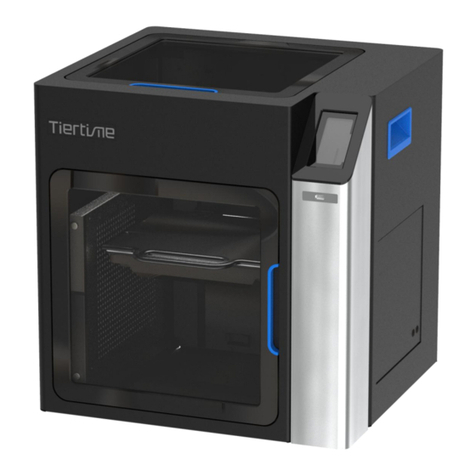
TierTime
TierTime UP300D User manual
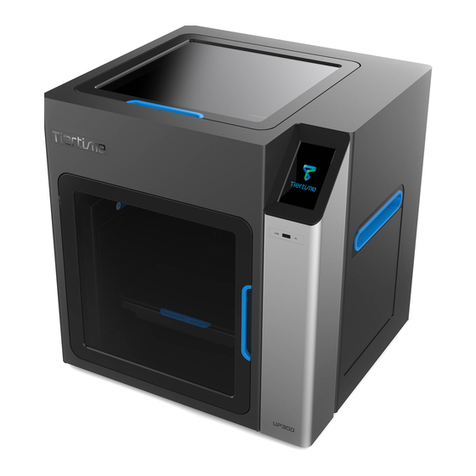
TierTime
TierTime UP300 User manual
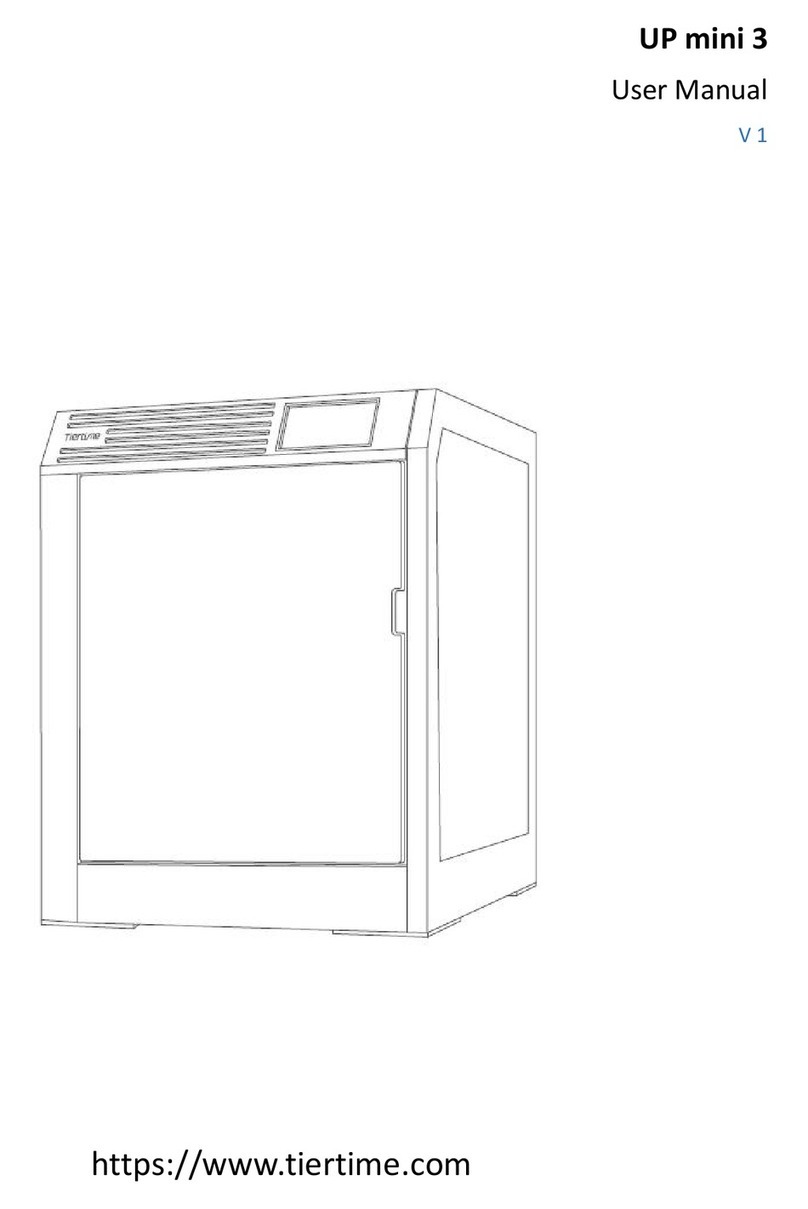
TierTime
TierTime UP mini 3 User manual
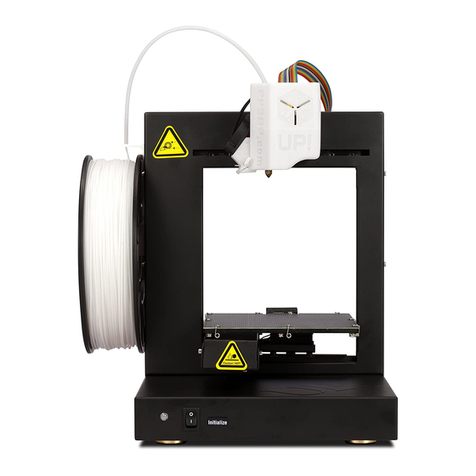
TierTime
TierTime UP Plus 2 User manual
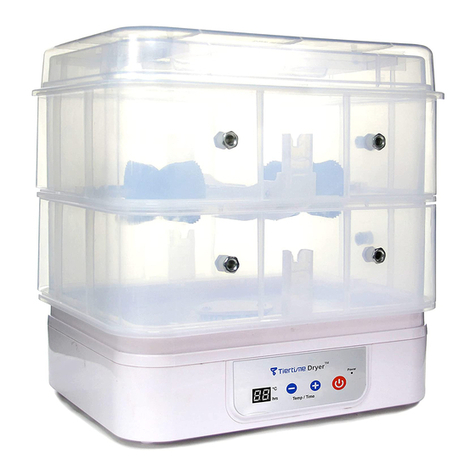
TierTime
TierTime Filament Dryer PRO User manual
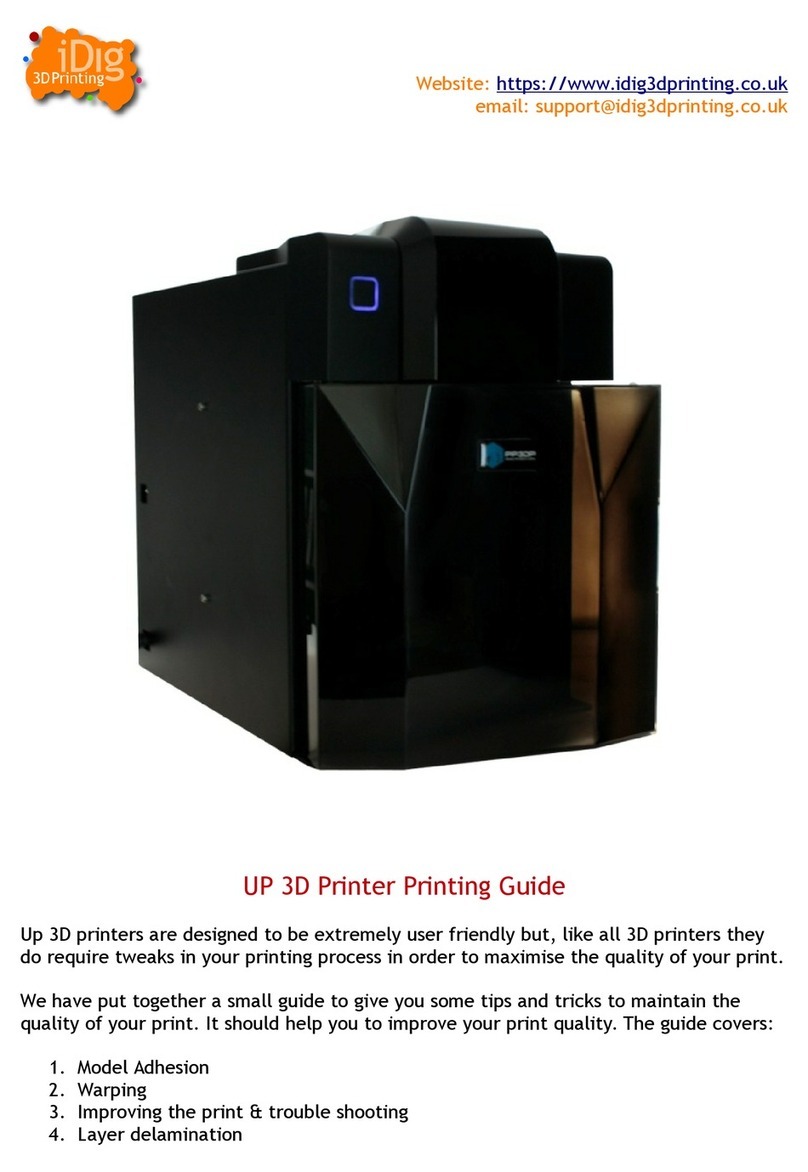
TierTime
TierTime UP mini 2 Configuration guide
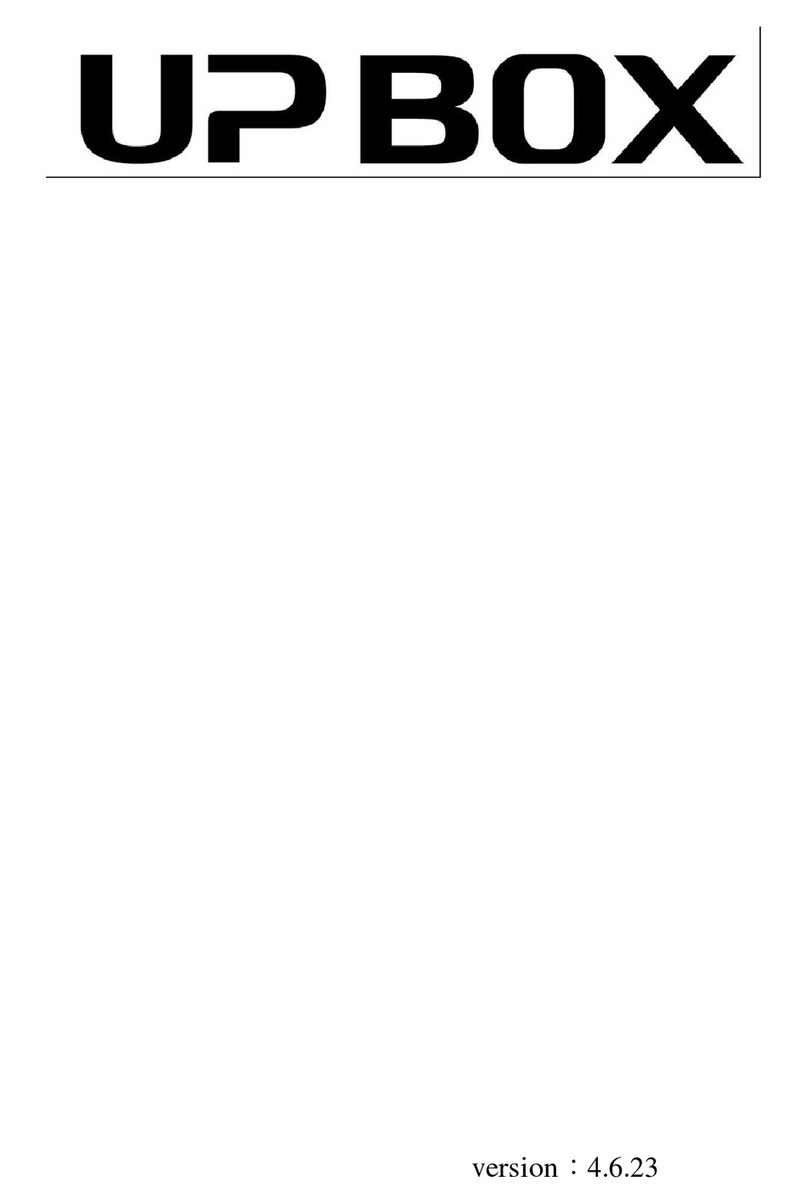
TierTime
TierTime UP BOX User manual
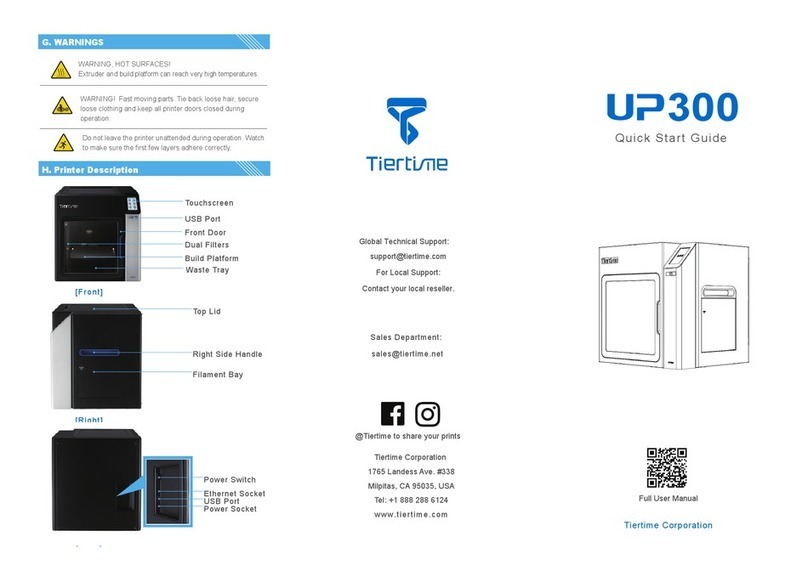
TierTime
TierTime UP300 User manual

TierTime
TierTime UP300D User manual
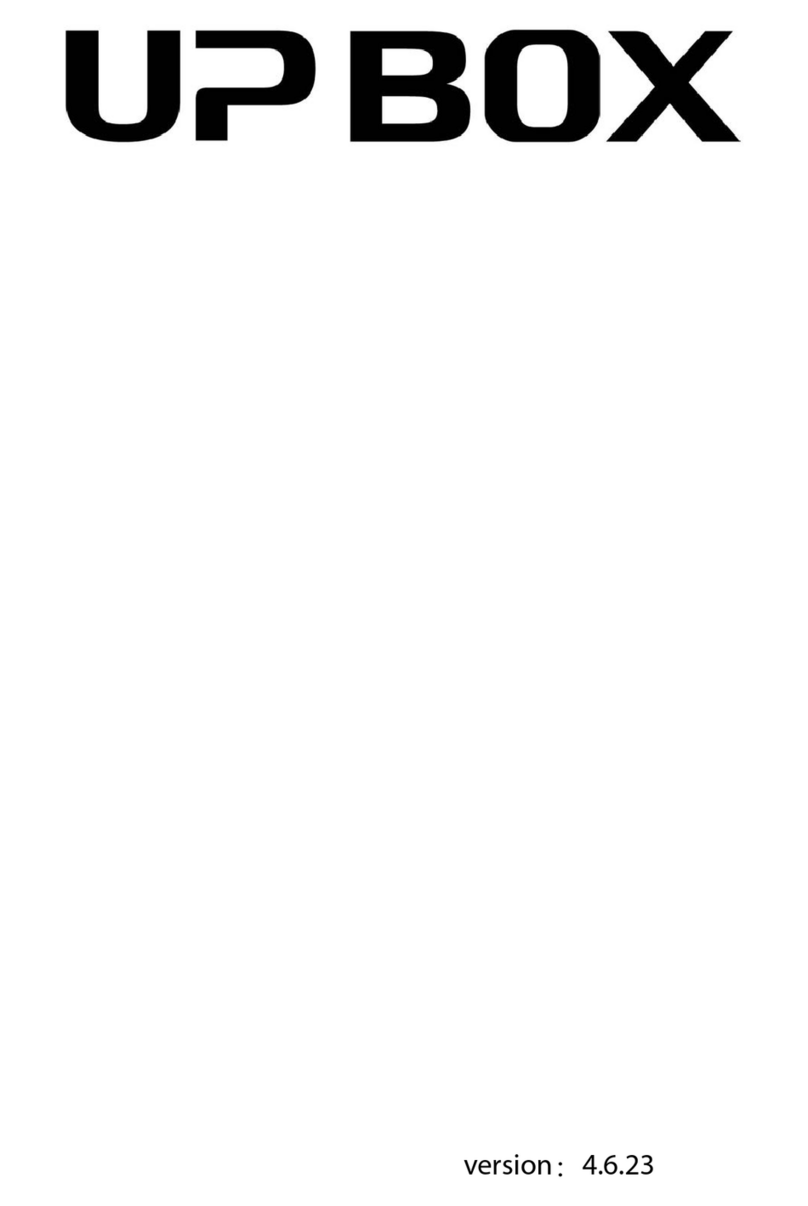
TierTime
TierTime UP BOX User manual
